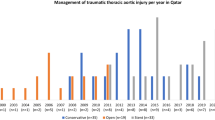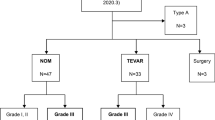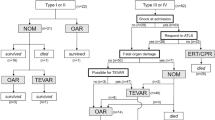Abstract
Introduction
Traumatic lesions of great vessels such as the aorta are life-threatening injuries. There is limited evidence about the influence of traumatic aortic injuries in multiple trauma patients in particular with regard to posttraumatic complications. The aim of this study was to evaluate the influence of blunt thoracic aortic injuries in multiple trauma patients compared to a multiple trauma cohort without this specific injury. In addition, the safety of Thoracic Endovascular Aortic Repair (TEVAR) in multiple trauma patients was analyzed.
Materials and methods
A retrospective study was performed. We included all multiple trauma patients (ISS ≥ 16, age > 14 years) between 2005 and 2014 with (group BTAI) and without (group nBTAI) blunt traumatic aortic injuries who were treated at our level-1 trauma center. Demographic as well as clinical parameters were analyzed including injury pattern, mechanism of injury, posttraumatic complications such as ARDS, multiple organ dysfunction syndrome (MODS) and others. A matched pair analysis was performed by propensity score matching.
Results
In total, 721 patients were enrolled (group BTAI: n = 45; nBTAI: n = 676). In the initial study population, surgical intervention was done in n = 32 (71.1%) patients (TEVAR: n = 25; 78.1%), there was an increased AISChest and overall injury severity in group BTAI with associated significantly more posttraumatic complications in group BTAI. The matched pair analysis consisted of 42 patients per group. Beside an increased ventilation time, no significant differences were evident after the matching process. There was a trend to increased risk for SIRS using binary logistic regression analysis.
Conclusions
Multiple trauma patients with blunt thoracic aortic injuries who are treated at a level-1 trauma center show a comparable outcome matched to their counterparts without aortic injuries. Our study confirms that using TEVAR in polytraumatized patients is a safe procedure. In all patients treated with TEVAR, there were no procedure-related complications, especially no neurological deficit.

Similar content being viewed by others
References
Franzen D, Genoni M (2015) Analysis of risk factors for death after blunt traumatic rupture of the thoracic aorta. Emerg Med J 32(2):124–129
Galli R et al (1998) Surgical indications and timing of repair of traumatic ruptures of the thoracic aorta. Ann Thorac Surg 65(2):461–464
Khoynezhad A et al (2015) One-year results of thoracic endovascular aortic repair for blunt thoracic aortic injury (RESCUE trial). J Thorac Cardiovasc Surg 149(1):155.e4–161.e4
von Oppell UO et al (1994) Traumatic aortic rupture: 20-year metaanalysis of mortality and risk of paraplegia. Ann Thorac Surg 58(2):585–593
Volodos NL et al., [A case of distant transfemoral endoprosthesis of the thoracic artery using a self-fixing synthetic prosthesis in traumatic aneurysm]. Grudn Khir, 1988(6): 84–86
Midgley PI et al (2007) Blunt thoracic aortic injury: a single institution comparison of open and endovascular management. J Vasc Surg 46(4):662–668
Demetriades D et al (2008) Diagnosis and treatment of blunt thoracic aortic injuries: changing perspectives. J Trauma 64(6):1415–1418 (discussion 1418–9).
Dyer DS et al (1999) Can chest CT be used to exclude aortic injury? Radiology 213(1):195–202
Baker SP et al (1974) The injury severity score: a method for describing patients with multiple injuries and evaluating emergency care. J Trauma 14(3):187–196
Greenspan L, McLellan BA, Greig H (1985) Abbreviated Injury Scale and Injury Severity Score: a scoring chart. J Trauma 25(1):60–64
Talmor M, Hydo L, Barie PS (1999) Relationship of systemic inflammatory response syndrome to organ dysfunction, length of stay, and mortality in critical surgical illness: effect of intensive care unit resuscitation. Arch Surg 134(1):81–87
Bone RC et al (2009) Definitions for sepsis and organ failure and guidelines for the use of innovative therapies in sepsis. The ACCP/SCCM Consensus Conference Committee. American College of Chest Physicians/Society of Critical Care Medicine. 1992. Chest 136(5 Suppl):e28
Marshall JC et al (1995) Multiple organ dysfunction score: a reliable descriptor of a complex clinical outcome. Crit Care Med 23(10):1638–1652
Sauaia A et al (2009) Validation of postinjury multiple organ failure scores. Shock 31(5):438–447
Knaus WA et al (1985) APACHE II: a severity of disease classification system. Crit Care Med 13(10):818–829
Jennett B, Bond M (1975) Assessment of outcome after severe brain damage. Lancet 1(7905):480–484
Bernard GR et al (1994) Report of the American–European Consensus conference on acute respiratory distress syndrome: definitions, mechanisms, relevant outcomes, and clinical trial coordination. Consensus Committee. J Crit Care 9(1):72–81
Huber S et al (2014) Predictors of poor outcomes after significant chest trauma in multiply injured patients: a retrospective analysis from the German Trauma Registry (Trauma Register DGU®). Scand J Trauma Resusc Emerg Med 22:52
Williams JS et al (1994) Aortic injury in vehicular trauma. Ann Thorac Surg 57(3):726–730
Kuhne CA et al (2005) [Traumatic aortic injuries in severely injured patients]. Unfallchirurg 108(4):279–287
Fabian TC et al (1998) Prospective study of blunt aortic injury: helical CT is diagnostic and antihypertensive therapy reduces rupture. Ann Surg 227(5):666–676 (discussion 676–677)
Parmley LF et al (1958) Nonpenetrating traumatic injury of the aorta. Circulation 17(6):1086–1101
Frantz TL et al (2016) Tissue damage volume predicts organ dysfunction and inflammation after injury. J Surg Res 202(1):188–195
Ryan M et al (2010) Thoracic aortic transection treated by thoracic endovascular aortic repair: predictors of survival. Vasc Endovasc Surg 44(2):95–100
Lin CC et al (2016) Blunt aortic injury: risk factors and impact of surgical approaches. Surg Today 46(2):188–196
Fabian TC et al (1997) Prospective study of blunt aortic injury: multicenter trial of the American Association for the Surgery of Trauma. J Trauma 42(3):374–380 (discussion 380–383)
Buz S et al (2008) Conventional surgical repair and endovascular treatment of acute traumatic aortic rupture. Eur J Cardiothorac Surg 33(2):143–149
Xenos ES et al (2008) Meta-analysis of endovascular vs open repair for traumatic descending thoracic aortic rupture. J Vasc Surg 48(5):1343–1351
Chung J et al (2008) Endovascular repair in traumatic thoracic aortic injuries: comparison with open surgical repair. J Vasc Interv Radiol 19(4):479–486
Kokotsakis J et al (2007) Endovascular versus open repair for blunt thoracic aortic injury: short-term results. Ann Thorac Surg 84(6):1965–1970
Canaud L et al (2015) Minimum 10-year follow-up of endovascular repair for acute traumatic transection of the thoracic aorta. J Thorac Cardiovasc Surg 149(3):825–829
Author information
Authors and Affiliations
Contributions
AO: Data management, Analysis and interpretation of data, writing of the manuscript, revision of the manuscript; CM: Study design, Analysis and interpretation of data, writing of the manuscript; EB: Analysis and interpretation of the data, manuscript revision; CS: Analysis of data, Revision of the manuscript; MW: Analysis and interpretation of data, revision of the manuscript; PM: Analysis and interpretation of data, revision of the manuscript; CK: Study design, interpretation of the data, revision of the manuscript; CZ: Study design, analysis and interpretation of the data, writing and revision of the manuscript.
Corresponding author
Ethics declarations
Conflict of interest
There are no commercial or similar relationships of the authors to products or companies related to the manuscript. No funding was necessary for this article. The article is not under consideration for publication in another journal, website or textbook. There are no competing interests.
Rights and permissions
About this article
Cite this article
Omar, A., Macke, C., Winkelmann, M. et al. Limited influence of blunt aortic injuries on the outcome of polytraumatized patients: a matched pair analysis. Arch Orthop Trauma Surg 138, 211–218 (2018). https://doi.org/10.1007/s00402-017-2842-4
Received:
Published:
Issue Date:
DOI: https://doi.org/10.1007/s00402-017-2842-4




